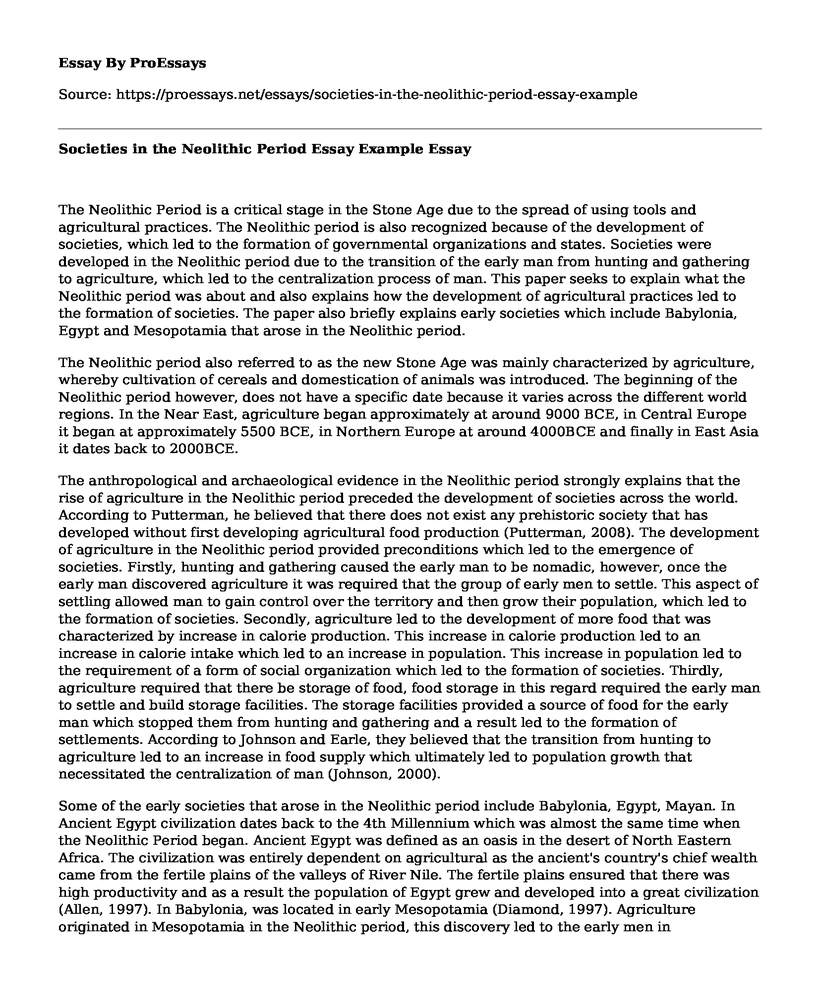The Neolithic Period is a critical stage in the Stone Age due to the spread of using tools and agricultural practices. The Neolithic period is also recognized because of the development of societies, which led to the formation of governmental organizations and states. Societies were developed in the Neolithic period due to the transition of the early man from hunting and gathering to agriculture, which led to the centralization process of man. This paper seeks to explain what the Neolithic period was about and also explains how the development of agricultural practices led to the formation of societies. The paper also briefly explains early societies which include Babylonia, Egypt and Mesopotamia that arose in the Neolithic period.
The Neolithic period also referred to as the new Stone Age was mainly characterized by agriculture, whereby cultivation of cereals and domestication of animals was introduced. The beginning of the Neolithic period however, does not have a specific date because it varies across the different world regions. In the Near East, agriculture began approximately at around 9000 BCE, in Central Europe it began at approximately 5500 BCE, in Northern Europe at around 4000BCE and finally in East Asia it dates back to 2000BCE.
The anthropological and archaeological evidence in the Neolithic period strongly explains that the rise of agriculture in the Neolithic period preceded the development of societies across the world. According to Putterman, he believed that there does not exist any prehistoric society that has developed without first developing agricultural food production (Putterman, 2008). The development of agriculture in the Neolithic period provided preconditions which led to the emergence of societies. Firstly, hunting and gathering caused the early man to be nomadic, however, once the early man discovered agriculture it was required that the group of early men to settle. This aspect of settling allowed man to gain control over the territory and then grow their population, which led to the formation of societies. Secondly, agriculture led to the development of more food that was characterized by increase in calorie production. This increase in calorie production led to an increase in calorie intake which led to an increase in population. This increase in population led to the requirement of a form of social organization which led to the formation of societies. Thirdly, agriculture required that there be storage of food, food storage in this regard required the early man to settle and build storage facilities. The storage facilities provided a source of food for the early man which stopped them from hunting and gathering and a result led to the formation of settlements. According to Johnson and Earle, they believed that the transition from hunting to agriculture led to an increase in food supply which ultimately led to population growth that necessitated the centralization of man (Johnson, 2000).
Some of the early societies that arose in the Neolithic period include Babylonia, Egypt, Mayan. In Ancient Egypt civilization dates back to the 4th Millennium which was almost the same time when the Neolithic Period began. Ancient Egypt was defined as an oasis in the desert of North Eastern Africa. The civilization was entirely dependent on agricultural as the ancient's country's chief wealth came from the fertile plains of the valleys of River Nile. The fertile plains ensured that there was high productivity and as a result the population of Egypt grew and developed into a great civilization (Allen, 1997). In Babylonia, was located in early Mesopotamia (Diamond, 1997). Agriculture originated in Mesopotamia in the Neolithic period, this discovery led to the early men in Mesopotamia to shift from hunting to agriculture. This shift led to settlements being established, these settlements led also included Babylonia. Babylonia further grew and became a huge civilization. The Mayan civilization was also based on agriculture, they used their experienced knowledge of seasons and calendars to plant crops (Sharer, 1994). The Mayans grew food in the mountainous highlands, swampy lowlands and in the dense forest for purposes of feeding the population. Agriculture led to the increase in population which later on led to the formation of the Mayan civilization.
Conclusion
As discussed above the Neolithic period led to the development of societies due to the shift from hunting and gathering to agriculture. Agriculture led to increase in food production and also contributed to the settling of the early man. The increase in food production led to increase in population which later led to the development of societies.
References
Allen, R. C. (1997). Agriculture and the Origins of the State in Ancient Egypt. Explorations in Economic History, 135-154.
Diamond, J. (1997). Guns. Germs and Steel: The Fates of Human Societies. Vintage.
Johnson, A. W. (2000). The evolution of human societies: from foraging group to agrarian state. Stanford University Press.
Putterman, L. (2008). Agriculture, diffusion and development: Ripple effects of the neolithic revolution. Economica, 729-748.
Sharer, R. J. (1994). The ancient maya. Stanford: Stanford University Press.
Cite this page
Societies in the Neolithic Period Essay Example. (2022, Nov 07). Retrieved from https://proessays.net/essays/societies-in-the-neolithic-period-essay-example
If you are the original author of this essay and no longer wish to have it published on the ProEssays website, please click below to request its removal:
- Essay Example on Same-Sex Marriage: A Historical Perspective
- Essay Example on Black Community's Quest for Freedom and Equality
- Greco-Persian Wars: Greek Victory in Delian League Conflict - Essay Sample
- The Value of Human Relationship: Philosophical Perspectives - Essay Sample
- Essay Sample on Improving Police-Community Relations in Canada: GPC Ltd's Solution
- Essay Example on Stereotypes: A Threat to Student Performance?
- Free Paper Sample: Mobile Home Resident / Symbol Management







